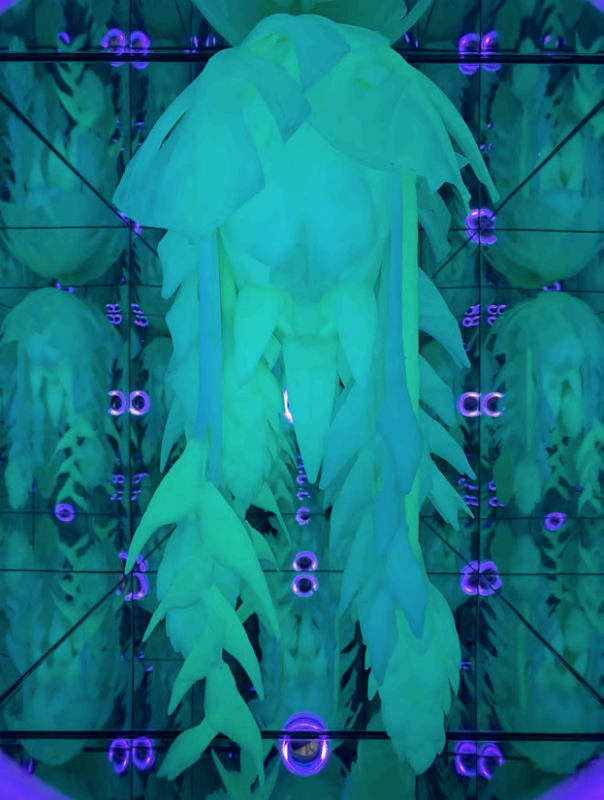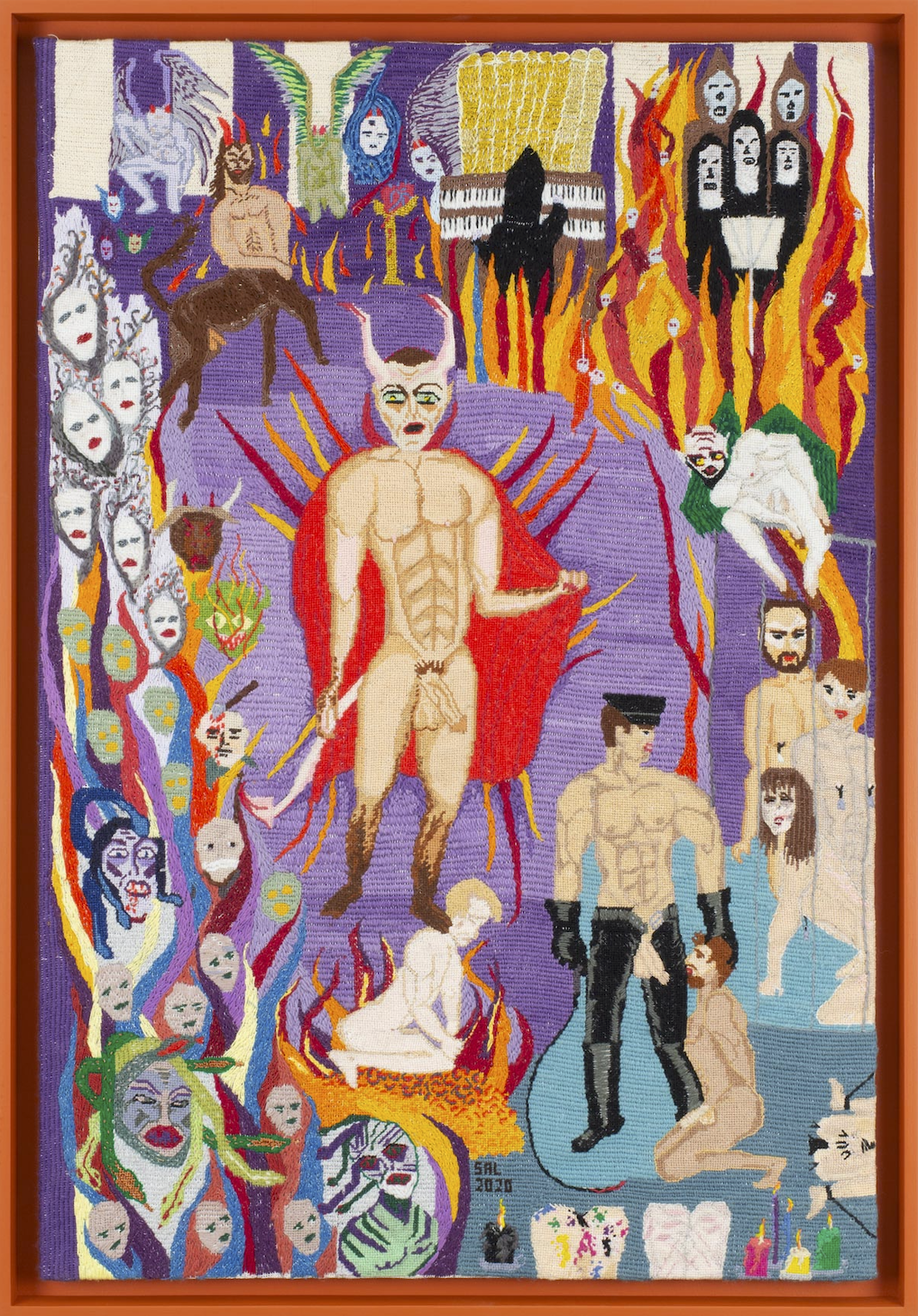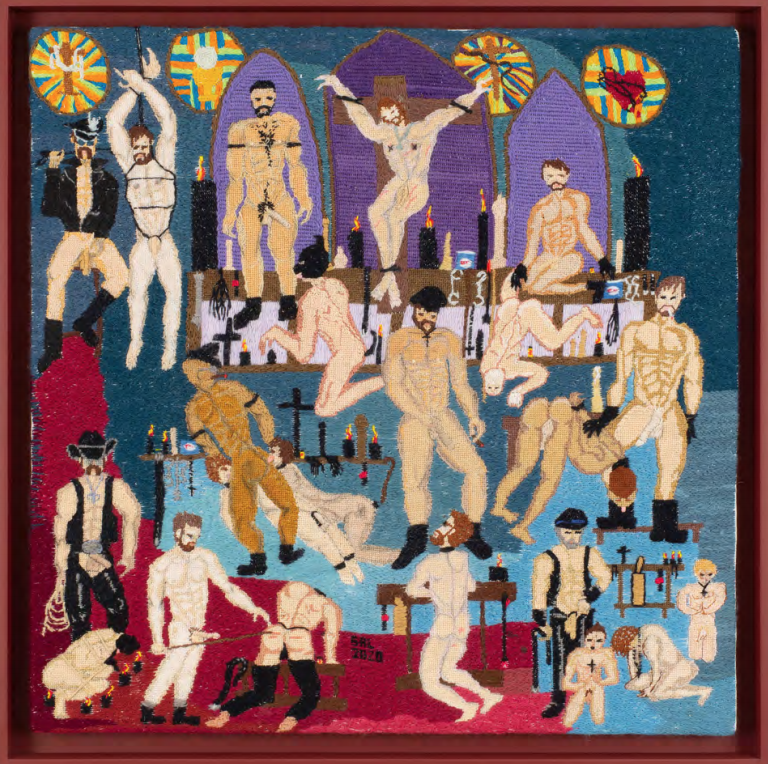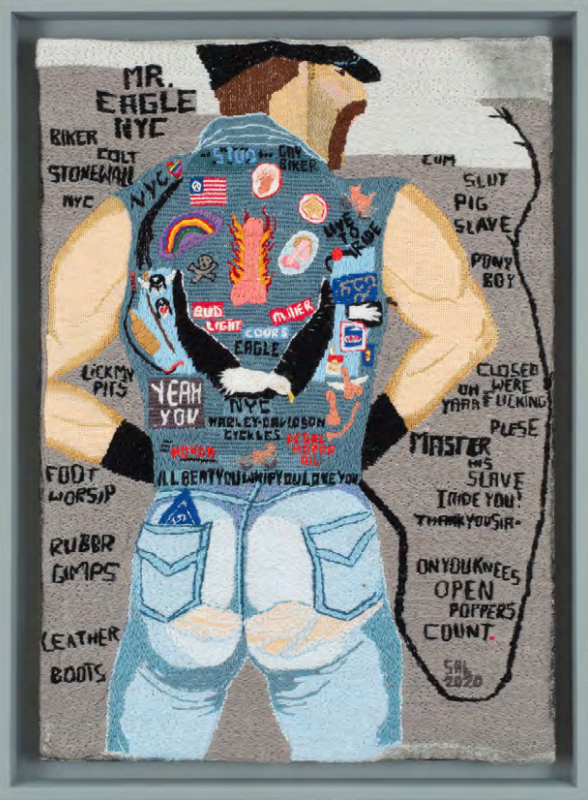SAL SALANDRA
Text by Michael Bullock,
Thread paintings by Sal Salandra
Club Rhubarb, 2021
Club Rhubarb is pleased to present Iron Halo, the first solo show of Sal Salandra, a self-taught Long Island-based artist who has been making thread paintings for the last 40 years.
Salandra was introduced to needlepoint by his mother-in-law in the early 1980s as a way to pass the time when he was sick and bedridden. The Catholic-raised, second-generation Italian-American started off creating traditional motifs — flowers and birds — but over the last decade the medium has become an outlet for him to explore his psychosexual desires. Salandra’s work celebrates his fantasies and documents the heights of his own lived BDSM experiences. With themes of repression, liberation, masculinity, worship, identity, and desire palpable in his images, he combines personal history, pop culture, and the lasting impact of the Catholic Church’s teachings. The 75-year-old artist’s highly-detailed narrative images intertwine these elements confronting the viewer with the joy, fear, catharsis, and the eccentricities embedded in fetish. Each of the intricate 14 pieces in this exhibition is a testament to the artist’s liberation from the “Iron Halo,” a metaphor for society's many powerful forces of sexual control.
Needlepoint is a craft primarily engaged in by suburban women that typically results in the creation of eyeglass cases, holiday ornaments, pillows, and upholstery. It’s a leisure pastime synonymous with a quaint heteronormative lifestyle. Salandra employs the same materials and techniques but instead of creating artifacts that embody wholesome all-American values, he uses the medium to showcase his own hard-fought personal freedoms, finding fearless self-acceptance through engaging in the group enjoyment of pleasures that mainstream society considers taboo (at best) and an abomination (at worst). Through his practice, Salandra has successfully queered needlepoint. Intrigue comes from the works’ ability to straddle two worlds. The innate innocence of the medium allows even the most conservative viewer to engage with the most extreme acts including: BDSM orgies featuring Christ’s crucifixion as the centerpiece (Say Your Prayers, 2020), S&M scenarios where cowboys turn their human slaves into animals, feeding them off the floor and riding on their backs (Save a Horse, Ride a Cowboy, 2020), Satan subjecting his foot slave to hot coals as the other souls in hell look on (Teachings of the Devil, 2019), or a reimagining of iconic comic characters Lois Lane and Superman as a dominatrix and human dog (Sunday Walk in the Park, 2021).
Salandra distinguishes his work with a term he coined, “thread painting,” and over the years, has further distanced his practice from traditional needlepoint by developing his own stitches: the elongated stitch, blind lock stitch, curve stitch, and save color stitch. These custom techniques developed to more accurately depict erotic imagery, have further moved the genre out of the realm of decorative craft and placed it back in line with the tradition of epic storytelling found in medieval tapestries. By infusing his chosen medium with the fetishistic obsessions and testosterone-fueled attention to detail associated with the leather community, of which he is a long-term member, he has unexpectedly opened a new inclusive, honest sexual space within the context of Americana.

In conjunction with Salandra’s exhibition is a site-specific installation titled, Andromeda VII, 2021 by New York City-based artist Desi Santiago. Andromeda, named after the sister galaxy to the Milky Way, was the name Santiago chose for his childhood alter ego, a shapeshifting warrior that gave the queer child a refuge from a Catholic school upbringing in which he felt alone. Andromeda laid the foundation for Desi Monster, the celebrated character that Santiago invented and embodied through New York City’s club-kid heyday. Over the last few years, the artist has been revisiting Andromeda, reinterpreting them in an ongoing multimedia series, which includes film, sculpture, and costumes. This presentation marks the first time he has given the character a stand-alone form. Referencing Étant donnés (Duchamp’s last major art work) the piece can only be viewed through a peephole in the gallery’s closet. Here the viewer finds a glow-in-the-dark face-like form that emerges out of tropical foliage, alluding to the artist's Puerto Rican heritage. Created from silicon, the semen-like qualities of the sculpture touch on the artist’s sexuality; an alter ego literally born from repressed libidinous energy. With this installation Santiago shares the private, creative inner world, developed to cope with the isolation he experienced as a queer child.


